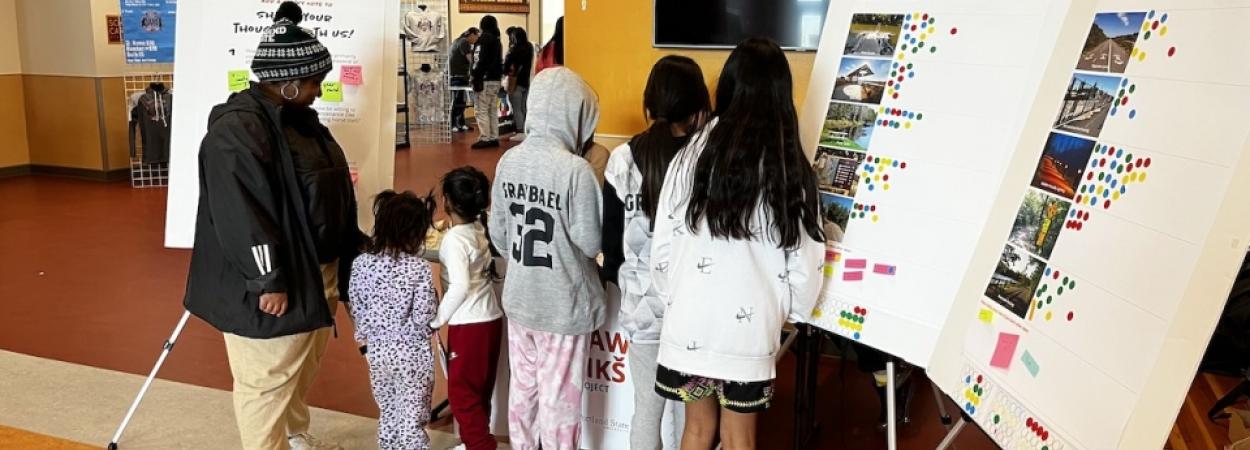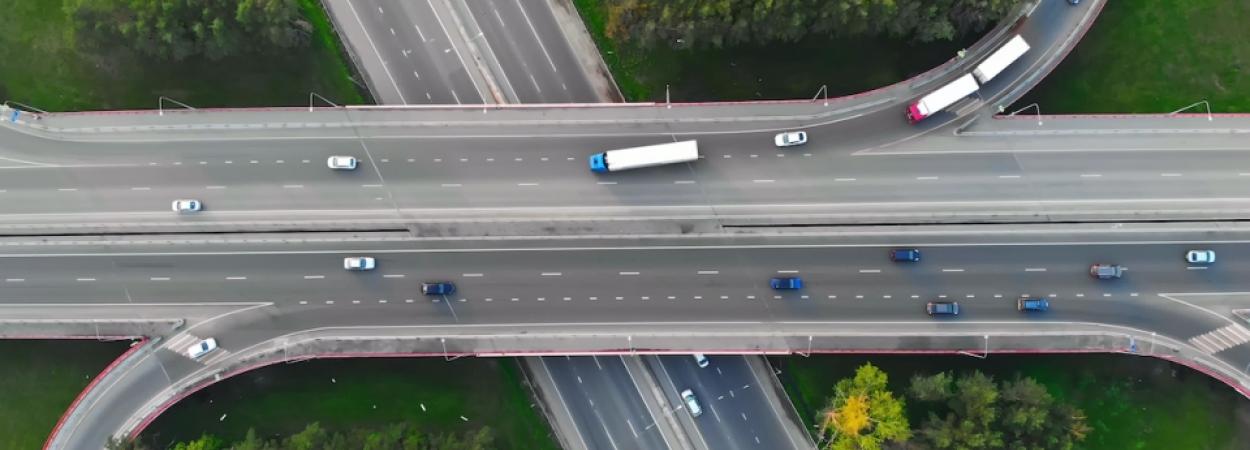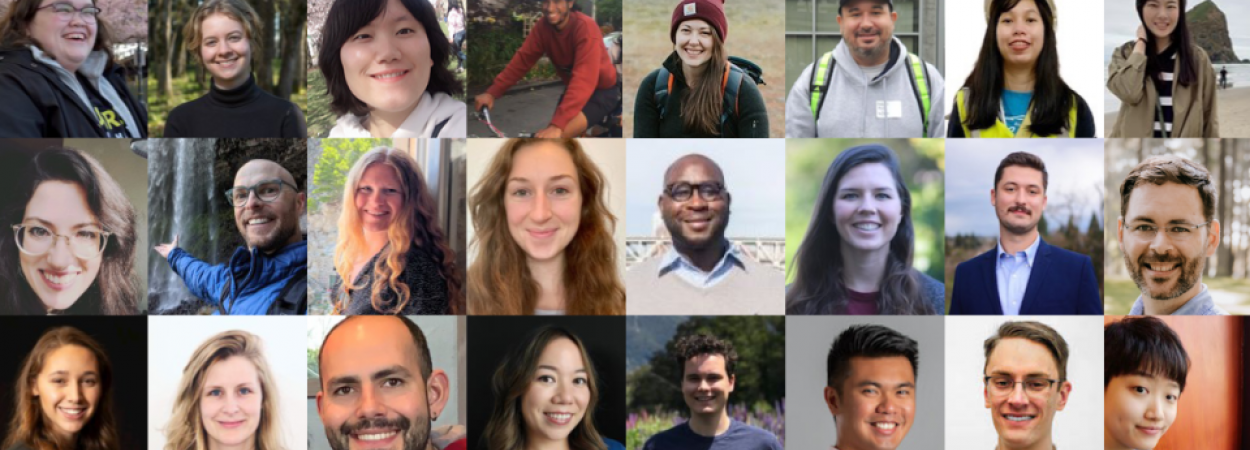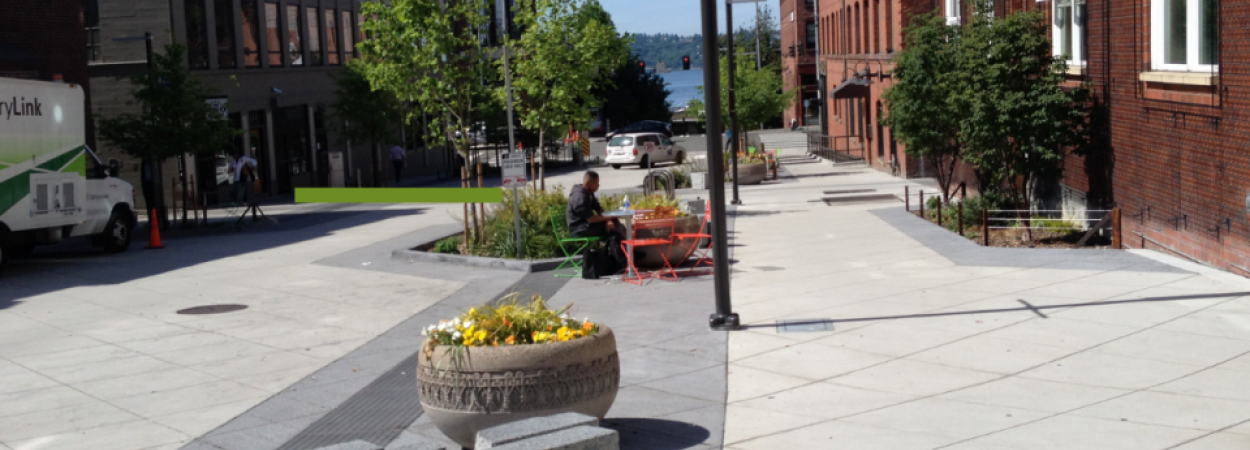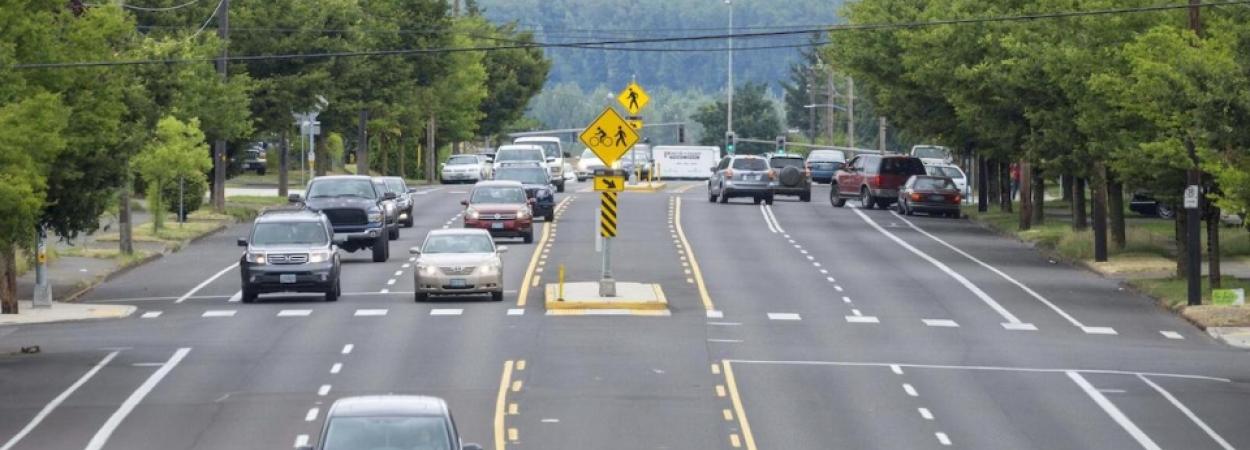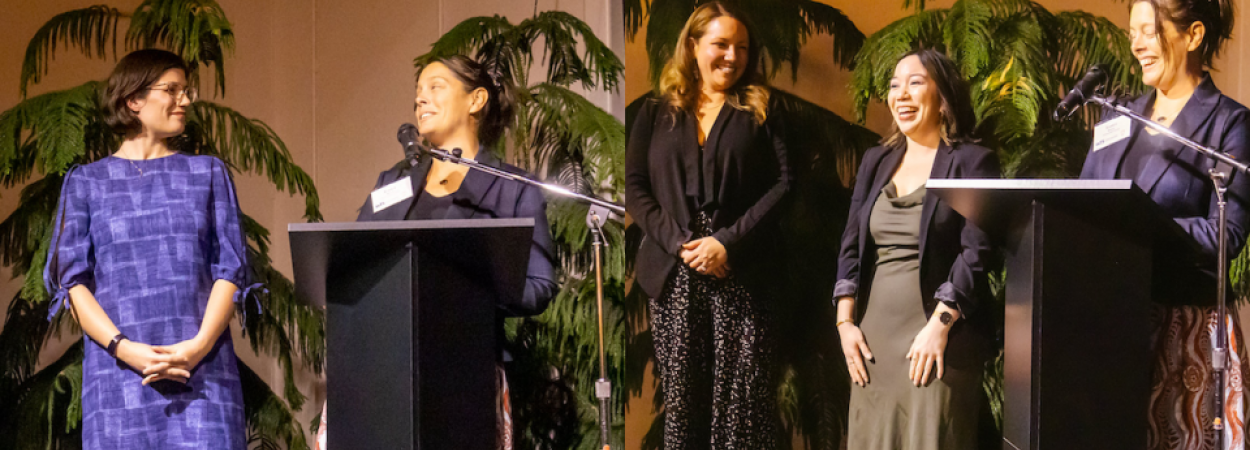Twenty-nine Portland State University students have been awarded National Institute for Transportation and Communities (NITC) scholarships for the 2022/23 academic year. We're very proud to acknowledge their hard work and dedication. The NITC Scholarship program recognizes outstanding students working on transportation projects. Financial support for students helps to develop the workforce by directing talented individuals toward research and practice, raising the number and caliber of graduates in transportation.
Meet the NITC Scholars of PSU:
Mackenzie Aamodt, Masters of Urban & Regional Planning
Mackenzie Aamodt is a student in the Masters of Urban and Regional Planning (MURP) program at Portland State University. Growing up in the Pacific Northwest and having access to green spaces, trails, and bike paths heavily influenced her decision to pursue a planning career. What interests Mackenzie most is how forgotten pieces of land or infrastructure can be used to build trails and areas of recreation in our communities. The rails to trails projects across the country have inspired her to pursue ways to provide access to nature and promote economic growth in urban and rural communities. In her free time she enjoys camping with her husband, cycling, reading, or learning to cook new recipes. In addition, Mackenzie is an active volunteer for Clackamas County Search & Rescue.
Connect with Mackenzie on LinkedIn.
Phil Armand, Bachelors in Civil and Environmental Engineering
Phil Armand is a bachelor of science in civil engineering (BSCE) senior at Portland State University, with a focus in transportation. His transportation interests include mass transit, pedestrian and bike design and safety, signal timing, lighting analysis, transportation justice and outreach. Phil is an Engineering Associate with the Portland Bureau of Transportation (PBOT) Signals, Street Lighting and ITS Division, and is a member of the Bureau’s Transportation Justice Steering committee. Prior to working for the City, Phil served the Oregon Department of Transportation Traffic Data Division and the Florida Department of Transportation State Materials Office. Phil is a member of the Institute of Transportation Engineers STEP and was recently nominated as Portland State University's ITE-STEP Community service and outreach chair.
Connect with Phil on LinkedIn.
Jamie Arnau, Masters of Urban & Regional Planning
Jamie Arnau is a second-year MURP student studying urban design. She is passionate about public space design, equity, and improving walking and transit experiences for all. She is a Junior Transportation Planner at Nelson\Nygaard Consulting Associates, supporting the firm's nationally recognized work in multimodal planning, demand management, and active transportation. Before pursuing a career in urban planning, she worked in her hometown of Los Angeles as a marketing manager in the hospitality, entertainment, and non-profit sectors. Outside of work, she enjoys singing karaoke and daydreaming about train rides in France and Japan. She earned her Bachelor's in Global Studies from UCLA in 2013.
Connect with Jamie on LinkedIn.
Cameron Bennett, Masters in Civil & Environmental Engineering
Cameron is a second-year master’s student in transportation engineering at PSU. His work as a graduate research assistant focuses on promoting and facilitating the uptake of active transportation modes. He serves as president of the PSU ITE-STEP (Students in Transportation Engineering and Planning) student group. He received Dwight David Eisenhower Transportation Fellowships presented by the U.S. Department of Transportation at the Transportation Research Board 2022 and 2023 annual meetings. His passion lies in the promotion of cycling in all its forms through engineering design, planning, policy, advocacy, and community-driven engagement. In his free time, you can usually find him moving through the mountains on a bike, vertical rock, a pair of skis, or his own two feet.
Connect with Cameron on LinkedIn.
Minji Cho, PhD in Urban Studies
Minji Cho is a PhD student and research assistant in Urban Studies. She worked with Dr. Jennifer Dill and Dr. Jenny Liu on a research project for Portland Metro, investigating the economic impacts of active transportation investments. Metro funded the research to better understand the role of these investments in building stronger communities in the region, and in implementing the Metro 2040 Growth Concept. Prior to coming to PSU, Minji was a full-time researcher at the Gyeonggi Research Institute in Gyeonggi, South Korea, working on the 2030 Gyeonggi Housing Plan (Housing and Welfare Policy).
Connect with Minji on LinkedIn.
Summer Cook, Masters of Urban & Regional Planning
Summer is a graduate student at Portland State University pursuing a Master's in Urban and Regional Planning with a focus on environmental planning, active transportation, and sustainable energy. She is an avid cyclist, zero-waste advocate, data nerd, reader, learner, and outdoorswoman.
Connect with Summer on LinkedIn.
Chris Corral, Dual Degree: Masters of Urban & Regional Planning + Masters of Public Health
Chris Corral is pursuing a dual degree in urban & regional planning and public health at Portland State University. He is passionate about ensuring all communities have access to safe, convenient, and healthy options for active transportation. Chris's most fulfilling work has been organizing adult and youth bike safety education programs in the Bay Area, including Safe Routes to School programming. This field combines his passion for biking and walking with his desire to improve the health of the communities he grew up in. Chris enters this program with a strong background in education, bike repair, and social theory.
Connect with Chris on LinkedIn.
Owen Christofferson, Masters of Urban and Regional Planning
Owen Christofferson is a second-year MURP student at Portland State University. He is interested in bike and pedestrian planning, transportation policy, and emerging transportation technologies. He serves as Vice President of Finance & Conferences for ITE-STEP, the PSU transportation student group, and as Chair of the Transportation Network Company (TNC) Advisory Committee for the Portland Bureau of Transportation. He has also worked as a Transportation Options intern for the City of Wilsonville, Oregon.
Connect with Owen on LinkedIn.
Miguel Gelin Ferreira, Masters of Urban & Regional Planning
Miguel is a MURP student at Portland State University.
Connect with Miguel on LinkedIn.
Sam Gallagher, Masters of Urban & Regional Planning
Sam is a graduate student pursuing a Master Degree in Urban and Regional Planning at Portland State University. Her career aspirations involve mainstreaming climate decisions and energy efficiency into economic development initiatives while making the cost of living more affordable. Sam previously worked on utility and affordable housing disputes for the Minnesota Attorney General's Office. She is from the Midwest but now call the Pacific Northwest her home.
Connect with Sam on LinkedIn.
Christian Galiza, Bachelors in Civil Engineering
Christian Galiza is a senior in civil engineering. He is the Vice President of Communications for STEP, and also works as a structural engineering intern for Eclipse Engineering. He is the recipient of an ITE Regional Travel Scholarship to attend the 2022 ITE Western District Annual Meeting in Palm Springs, CA. Christian enjoys transportation because it's fascinating to think about the relationship between building sustainable infrastructure and transportation planning and its impact on how people move every day.
Connect with Christian on LinkedIn.
Cole Grisham, PhD in Public Affairs and Policy
Cole Grisham is a Transportation Systems Planner with FHWA Western Federal Lands. His work focuses on long range transportation planning, particularly in the areas of regional and intergovernmental policy in the American Northwest. He is a certified planner through the American Planning Association and holds a B.A. in Political Science and M.U.P. in Regional Planning from the University of Michigan. Cole is currently pursuing a Ph.D. in Public Affairs from Portland State University.
Connect with Cole on LinkedIn.
Kristina Henry Hall, B.S. in Civil and Environmental Engineering
Kristina Henry Hall is a Civil Engineering/Business Analytics Student pursuing strategic planning & program management. She is a US Army & Air Force Veteran. An entrepreneur at heart, Kristina loves transforming visions into reality. Her mantra is: Successful businesses serve people passionately with a purpose. Besides people, her passions include philosophy, real estate, and new ideas.
Connect with Kristina on LinkedIn.
Meredith Herbst, Masters of Urban and Regional Planning
Meredith Herbst is a first-year MURP student at Portland State University. She currently interns as a Comprehensive Plan Project Assistant for the City of Vancouver, Washington, where she provides assistance and support to Long Range Planning Staff with general project management, research, and data analysis for the update process to the City’s Comprehensive Plan. She earned her BS in Geography from the University of Georgia (UGA), and serves as the Philanthropy Chair for the UGA Alumni Association's Portland Chapter. Originally from Dallas, Meredith is enjoying becoming immersed in the Pacific Northwest community.
Connect with Meredith on LinkedIn.
David Hoang, B.S. in Urban & Public Affairs
David Hoang is an undergraduate studying urban & public affairs at PSU. He grew up in different neighborhoods across Portland. As a young teen, he joined the Multnomah Youth Commission where his team advocated for policies in education and transportation justice, which included pushing the YouthPass bus fare program out into high schools like David Douglas and Parkrose. In 2021, he worked as a Safe Routes to School Program Assistant for the Portland Bureau of Transportation (PBOT). David is a member of the Institute of Transportation Engineering, the Institute of Real Estate Management, and is currently on the leadership board for the STEP (Students in Transportation Engineering and Planning) student group.
Connect with David on LinkedIn.
Kyu Ri Kim, PhD in Urban Studies
Kyu Ri is a Ph.D. student in urban studies at the Nohad A. Toulan School of Urban Studies and Planning. She is a recipient of the Nohad and Dirce Toulan Endowed Scholarship and a Ph.D. student rep for this 2021-22 academic year. She is studying on pedestrian safety and active transportation with Dr. Jennifer Dill. She also worked for the Research Roadmap for the AASHTO Council on Active Transportation and Active Transportation Return on Invenstment Study at PSU. She achieved B.S. and M.S. degrees in Urban Planning and Engineering from Yonsei University in South Korea and worked as a researcher for Korea Environment Institute and The Seoul Institute. She is a 2022 recipient of the IBPI Excellence in Active Transportation Scholarship.
Connect with Kyu Ri on LinkedIn.
Minju Kim, PhD in Urban Studies
Minju Kim is a PhD student in Urban Studies in the Nohad A. Toulan School of Urban Studies and Planning with a specialization in transportation and gerontology, and candidates graduate certificate program in the Institute of Aging. She received a Master's degree in Transportation Studies from Seoul National University and studied in Urban Planning for Bachelor from Chung-Ang University from South Korea. Her current research interest focuses on transportation for older people, and she would like to research the differences in preference and trends of older adults. She worked on a TREC project about the impacts of shared E-scooter operations during the 2019-2020 Portland Pilot Program with John MacArthur and Jennifer Dill. In order to improve the accessibility and sustainability of micromobility systems to the citizens of Portland, this research focuses on the impacts of scooter operations on VMT, including scooter deployment, rebalancing, and charging.
Connect with Minju on LinkedIn.
William McKenzie, Master of Civil and Environmental Engineering
A master of science in civil & environmental engineering student, Will has been preoccupied with people, planes, trains, and automobiles since as long as he can remember. He is keen on mobility and electric vehicles (EVs), equal access/opportunity for all, statistics, data, logistics, behavior, planning, and policy.
Connect with William on LinkedIn.
Megan Lee, Masters in Civil & Environmental Engineering
Megan Lee is a civil engineering master's student at Portland State University. She serves as the Vice President of Events for ITE-STEP, the PSU transportation student group, and during her undergraduate study at Oregon State University, she also served as the Community Service Chair for their ITE student chapter. She worked as an engineering intern for the Washington State Department of Transportation in 2020, and is currently interning as a Student Design Trainee at the San Francisco Municipal Transportation Agency (SFMTA).
Connect with Megan on LinkedIn.
Elias Peters, Dual Degree: Masters in Urban & Regional Planning + Masters in Civil & Environmental Engineering
Elias is an adventurous, hard-working graduate student at Portland State University. They are a first year dual masters degree student in Urban and Regional Planning and Civil Engineering. Elias has a love for public transit and active transportation, and they are interested in learning how to improve transportation route planning and infrastructure so it is more community centered, safe, efficient, and accessible for all. Elias is the current Vice President of Communications for ITE-STEP, the PSU ITE student chapter. They graduated from Western Washington University in 2019 with a bachelor’s degree in Statistics and a minor in Environmental Science, and now work for Washington State Department of Transportation (WSDOT).
Connect with Elias on LinkedIn.
Maddy Poehlein, Dual Degree: Masters of Urban and Regional Planning + Masters of Public Health
Maddy is a dual master's degree candidate in Public Health and Urban and Regional Planning at Portland State University. She is interested in studying how unequal access to services, such as public transportation, and how individuals are situated within the built physical environment impacts population health. Maddy earned a BA in Environmental Studies and Politics with Honors from Whitman College, taking classes in environmental policy, environmental justice, and environmental health. She views the intersection of planning and public health as a way to work towards environmental and climate justice. She also is an avid cyclist, outdoors person and a certified Wilderness First Responder.
Connect with Maddy on LinkedIn.
Gabriel Quiñones-Zambrana, PhD in Urban Studies
Gabriel Quiñones-Zambrana is a first-year Ph.D. student in urban studies at the Nohad A. Toulan School of Urban Studies and Planning. He studies transit & transportation planning, transit equity, land use planning, complete streets, and active modes of transportation. Before coming to study at PSU he worked in the private sector as a Transit and Transportation Planner, and in the public sector as the Director of a Planning Department in a municipality, for more than 8 years combined. Currently he works as a graduate research assistant (GRA) for PSU's Transportation Research and Education Center (TREC), supporting advisor Hau Hagedorn in tasks related to the Better Block PSU program and various research projects.
Connect with Gabriel on LinkedIn.
Aidan Simpson, Masters of Urban & Regional Planning
Aidan Simpson is a current Masters of Urban and Regional Planning student at Portland State University interested in transportation and transportation equity. In 2022, Aidan was part of a team (along with Cameron Bennett, Owen Christofferson and Emily D’Antonio) that created a Downtown Portland Living Streets Plan centered around a new street typology for Portland: Living Streets. Like the public plazas common in cities outside the US, living streets are defined by slow speeds and shared space. But unlike European old towns, Dutch Woonerfs or Barcelona's Superblocks, Living Streets were designed specifically with Portland in mind.
Connect with Aidan on LinkedIn.
Caleb Susuras, Masters of Urban & Regional Planning
Caleb Susuras is a second-year MURP student who earned his BA from Ambrose University. He has experience as a voucher specialist with the Denver Regional Council of Governments, and has also worked for the Denver Regional Mobility and Access Council. He is committed to safe, equitable, and green streets.
Connect with Caleb on LinkedIn.
Isa Swain, B.S. in Civil and Environmental Engineering
Isa is a first-year undergraduate student pursuing a B.S. in civil engineering at Portland State University. As someone who is passionate about sustainable urban design, she wants to continue learning about how transportation systems impact the environment and the health of communities. She currently serves as an officer for PSU'S ITE student chapter, Students in Transportation Engineering and Planning (ITE-STEP).
Connect with Isa on LinkedIn.
Dawn Walter, Masters of Urban & Regional Planning
Dawn is a first-year Master of Urban and Regional Planning student at Portland State. She is also pursuing a Graduate Certificate in Gerontology. Her focus within the planning program is transportation with a special emphasis on improving mobility for older adults and persons with disabilities. She is also the Spring/Summer Transportation Intern at the Portland office of WSP and serves on the Fixing Our Streets Oversight Committee for the City of Portland. Before pursuing a career in urban planning, she worked in arts administration at Opera Theatre of Saint Louis.
Connect with Dawn on LinkedIn.
Ciara Williams, Masters of Urban & Regional Planning
Ciara is a graduate student of Portland State University studying Urban Design, Public Interest Design, and Active Transportation.
Connect with Ciara on LinkedIn.
Cassie Wilson, B.S. in Liberal Studies; minor in Community Development
Cassie Wilson is a current undergraduate student at Portland State University working on a degree in Liberal Studies with a minor in Community Development. Her interests are transportation, land use, housing, planning, local government and politics, climate action, and disability and social justice.
Connect with Cassie on LinkedIn.
Elizabeth Yates, Master of Civil and Environmental Engineering
Elizabeth Yates is a graduate student of transportation engineering at Portland State University.
Connect with Elizabeth on LinkedIn.
NITC is a program of the Transportation Research and Education Center (TREC) at Portland State University. This PSU-led research partnership also includes the Oregon Institute of Technology, University of Arizona, University of Oregon, University of Texas at Arlington and University of Utah. Faculty committees at each of our partner universities nominate students for the scholarship program. Learn more about the NITC scholarship program and see the NITC scholars from other member campuses.
Portland State University's Transportation Research and Education Center (TREC) is home to the U.S. DOT funded National Institute for Transportation and Communities (NITC), the Initiative for Bicycle and Pedestrian Innovation (IBPI), PORTAL, BikePed Portal and other transportation grants and programs. We produce impactful research and tools for transportation decision makers, expand the diversity and capacity of the workforce, and engage students and professionals through education and participation in research.


